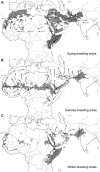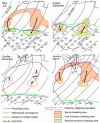Sky Compass Orientation in Desert Locusts-Evidence from Field and Laboratory Studies
- PMID: 26733834
- PMCID: PMC4679860
- DOI: 10.3389/fnbeh.2015.00346
Sky Compass Orientation in Desert Locusts-Evidence from Field and Laboratory Studies
Abstract
Locusts are long-range migratory insects. At high population density, immature animals form marching hopper bands while adults take off and form huge swarms of millions of animals. At low population densities animals are solitarious, but likewise migrate, mostly during the night. Numerous studies aimed at predicting locust infestations showed that migrations both as hopper bands and as adults are largely downwind following seasonal shifts of the tropical convergence zone taking the animals to areas of rainfall. Only a few studies provided evidence for active orientation mechanisms, including the involvement of a sun compass. This scarcity of evidence stands in contrast to recent neurobiological data showing sophisticated neuronal adaptations suited for sky compass navigation. These include a special dorsal eye region with photoreceptors suited to analyze the polarization pattern of the sky and a system of topographically arranged sky compass neurons in the central complex of the brain. Laboratory experiments, moreover, demonstrated polarotaxis in tethered flying animals. The discrepancy of these findings call for more rigorous field studies on active orientation mechanisms in locusts. It remains to be shown how locusts use their internal sky compass during mass migrations and what role it plays to guide solitarious locusts in their natural habitat.
Keywords: animal migration; desert locust; insect brain; polarization vision; sky compass orientation.
Figures




References
-
- Backasch B. (2009). Untersuchungen zur Phototaxis und Polarotaxis Fixiert Fliegender Wüstenheuschrecken. Diploma thesis: University of Marburg, Marburg.
-
- Baker R. R. (1978). The Evolutionary Ecology of Animal Migration. London: Hodder and Stoughton.
-
- Baker P. S., Gewecke M., Cooter R. J. (1984). Flight orientation of swarming Locusta migratoria. Physiol. Entomol. 9, 247–252. 10.1111/j.1365-3032.1984.tb00706.x - DOI
Publication types
LinkOut - more resources
Full Text Sources
Other Literature Sources
Miscellaneous

